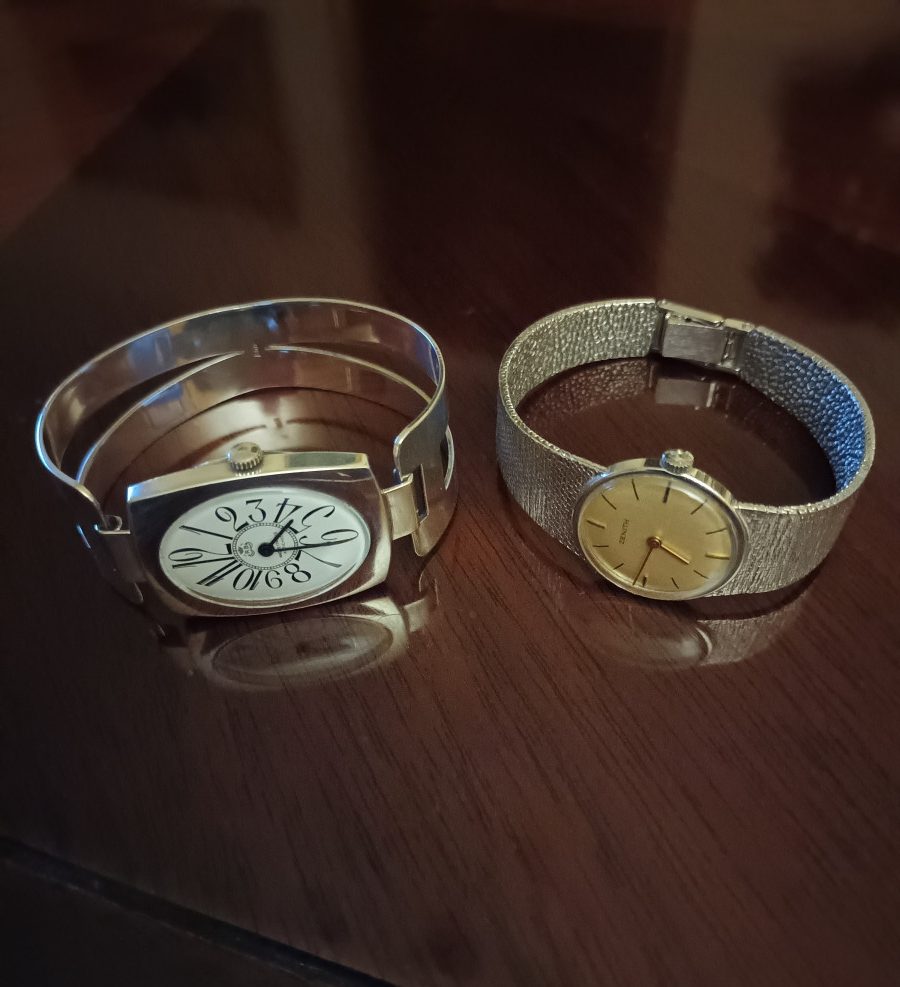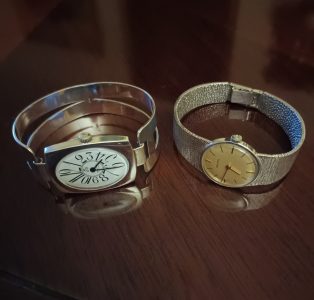An initial admission! I have never bought a ladies dress watch – let alone two! How come? Well, I simply saw these on my pal James Kibble’s watch site, and my interest was piqued as they were both made of silver – cases and bracelets. I happen to like silver and collect all sorts of things – but mainly of an antique type. So, as these intrigued me, I decided to enquire further and maybe do a deal! As James does not really major in ladies watches he was quite content to negotiate, with the upshot being that I bought both! What follows is no usual in-depth review – as information is a bit limited really, so, I just offer what I can and some images.
Zenith
The first watch is a Zenith dress watch, with an integrated “bark” effect bracelet. All is in sterling silver. The round case is simply finished and polished, and at some 24mm pretty small – but usual for it’s age. It has a champagne silver coloured dial, with gold hands and hour battens. An unremarkable marked crown is present.

In terms of age, the UK hallmarks on the inside of the case back provide a reasonably accurate indication. These reveal a London assay of 1976. The ratchet type clasp on the bracelet also has the same hallmarks. There is a makers mark of DS&S. This denotes David Shackman & Sons who were a quality and well-known firm in London through the 50’s and 70’s. They specialised in jewellery – and in particular bracelets and watch cases.

The motive power is a Zenith caliber1740, which has 17 jewels and a power reserve of some 38 hours. This movement originated in the 1950’s and went through to the 1970’s, and because of it’s small size was perfect for cocktail watches.

Lastly, the bracelet. As mentioned, this is integrated and the visible side is of a “bark” finish – pretty common in the 60’/70’s. The inside though has an almost lizard skin finish, as can be seen in the second image.

The bracelet and clasp are again of a fairly common design of the day, and reminiscent of Rolex and Omega offerings. In particular, on the latter’s Constellation range. As such, there are three size options available.

The overall condition is very good – a couple of scratches excepted. There was one on the clasp, but I have dealt with that, and another on the case back I am confident I can also remedy. This watch is by a top class and highly regarded maison and jeweller, and runs well and accurately.

In conclusion, I bought the watch at a good price, and with my finishing improvements and finding out a bit more about it, feel it to be worth around £500-£550.
RB
I now turn to the other watch, which in some ways is a bit more interesting. This is made by RB. Who, I hear you ask? Well, that is a reasonable question as I had never heard of them either – or my chum James too for that matter. Anyway, the internet is great for some things and I have found out more, but not much!

I have found a few vintage watches from the 50s/60s with the RB moniker – but precious little else. The only one explanation offered – by one seller, is that Hans Wilsdorf (of Rolex) and Ernst Bucherer (Bucherer – very high end French jeweller) collaborated from 1924. However, a temporary falling out in the 60’s led to Bucherer producing watches under the RB (Rolex Bucherer one assumes. Ed) name, but without Rolex movements. I’ll admit all this seems a bit tenuous, but not impossible. I do note that the symbol on the watch face is a crown, very similar to the Rolex one. However, I will now turn to the watch.

The watch is entirely made of silver – including the bracelet. On inspecting the case back and the bracelet, there are hallmarks – but they are not British, but French. This is evidenced by the Swan mark on the case back. In fact there are two, as this denotes the fact that there are two silver components, i.e. the case and bracelet. This mark was used between 1893 and 1970 and confirms an 800 silver standard – so slightly less than our Sterling one. There is another mark – which I suspect is the maker, but unfortunately it is too worn to read. Whatever, the evidence is there to say that it is essentially a French made watch (with a Swiss movement) and likely made in the mid-sixties.

The case – some 26mm, is of a barrel – or tonneau type shape. This and the “crazy” type of Arabic numerals on a white dial, certainly hark back to the Art Deco age. There is the crown logo and RB under 12 o’clock, and above 6 o’clock is noted “Ancre” – meaning the watch has a lever escapement, plus 17 Rubies and Antichoc (antishock) are also noted.

The movement is a manual Swiss FHF caliber 69. This has 17 jewels and a useful power reserve of some 46 hours on a full wind. This movement appears to have been used between 1962 and 1966. This again fits in with the date of the so-called Rolex/Bucherer story. FHF (Fabrique d’Horlogerie de Fontainemelon) roots go back to 1793 with three founders, and by 1876 was producing some 240,000 movements a year! They merged with Landeron in 1925 and was a founding member of Ebauches SA in 1926. It evolved and was absorbed by ETA in 1985. Again, this all seems to indicate a mid sixties manufacture of the watch.

Lastly, the bracelet. This is of a “bangle type, which is skeletonised. One side is fixed to the case via a hinge, the other end just loops over a wide bracket hook fixed to the other side of the case. One has to squeeze the whole bracelet onto the hook, then release, and it is now pretty firmly attached. The only slight downside is that there is no size adjustment and it is on the small side.
This is a fascinating and attractive timepiece. Yes, it is not a famous brand name with high horlogerie, but I think it is pretty unique being all in silver and I cannot see another one at all. The Rolex/Bucherer story is interesting, and could be true – but no guarantees! It also seems to run fine to boot! As to a value? This is a bit more tricky, but I feel that the piece’s uniqueness, attractiveness, and silver value, would command around £650-£750.
That, as they say, is that!
Words and Images: The Writer – unless noted otherwise.


